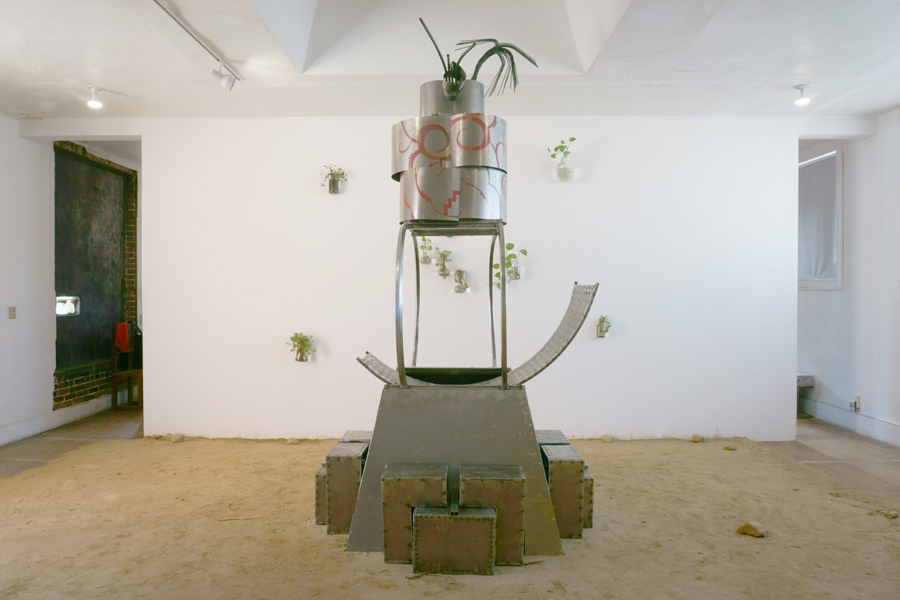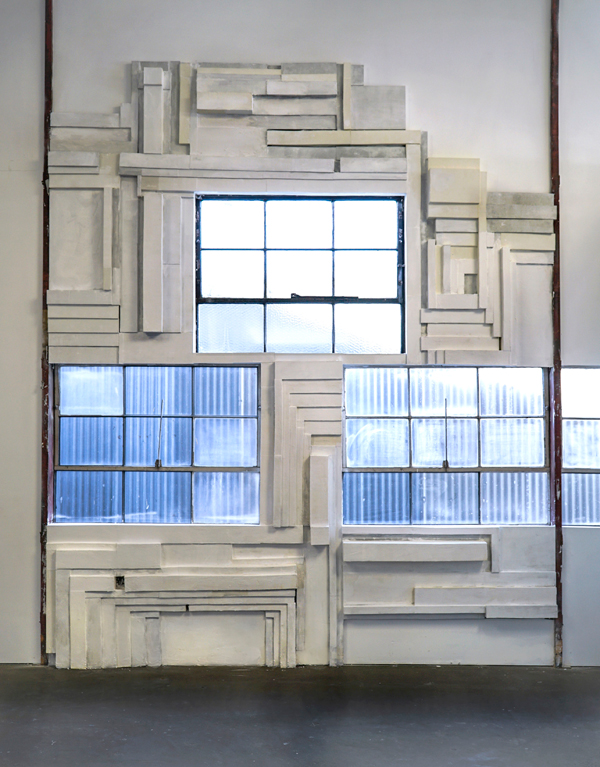Critic’s Guide: Los Angeles
Ahead of the Art Los Angeles Contemporary art fair this weekend, a guide to the best shows in the city
Ahead of the Art Los Angeles Contemporary art fair this weekend, a guide to the best shows in the city


Lawrence Abu Hamdan
Hammer Museum
20 January – 20 May
Saydnaya, a military prison near Damascus, confirms some of our worst fears about the current state of Syria. The still-active, Assad-controlled institution operates in complete darkness (a lack of sunlight as well as transparency), and has its own crematorium. Given that three quarters of detainees never make it out, the testimonies of its survivors are all the more valuable for the insight they provide into the complex’s machinations.
Using a method of ‘echo profiling,’ Lawrence Abu Hamdan has reconstructed a model of the prison, one as atmospheric as it is architectural. Using evidence gathered from Amnesty International and the London group Forensic Architecture, as well as prisoners’ scant yet highly attuned ‘ear-witness’ accounts – counting guards’ footsteps as a measure of hallways; tempting sparrows with morsels of food to gauge the birds’ reactions to approaching wardens – the parameters of the centre are presented simply as acoustic track and graphite blueprints on white walls via an overhead projector. Stripping away sensory stimulus creates its own torture.

‘Dining with Kings: Ceremony and Hospitality in the Cameroon Grassfields’
Fowler Museum
17 December – 8 April
Inside ‘Intersections: World Arts, Local Lives’, a long-term exhibit of artworks from Africa, Asia, and the Americas ranging from 3000 BCE till now, is ‘Dining with Kings’, a display of vessels for food used by Cameroonian royalty, specifically the king of the nation’s volcanic Grassfields region. The sumptuous 19th- and 20th-century relics include palm wine gourds covered in burlap and graphic patterns modelled after ‘the earth spider’ (a spindly creature who moves between lives below and above ground, the human and spirit worlds); exquisitely carved wooden bowls to hold kola nuts, whose handles depict human appendages or jungle animals, and a round wooden pedestal meant for royal reception chambers with a ring of human faces at its base. The opulent spread is ultimately set up for the most decadent respite: the king always dines alone.

Beatriz Cortez and Rafa Esparza ‘Pasado mañana’
Commonwealth and Council
20 January – 3 March
A wander through a garden of low, rich loam, is cut short by a turn into a hallway – one on the second floor of a colour-blocked Art Deco building in Koreatown. Los Angeles artists Beatriz Cortez and Rafa Esparza have collaborated again to fertilize this room-sized square of territory, as well as the wall panels enclosing it, as a nursery for six invited artists – Fabián Guerrero, Sebastián Hernández, María Maea, Rubén Rodríguez, Gabriela Ruiz, and Brenzy Solorzano.
The exhibition takes its title from the Spanish phrase for ‘the day after tomorrow,’ but its literal translation is much more lyrical: ‘when tomorrow has passed.’ The term’s future perfect tense gives name to expectant prospects, one where the artists see fluid notions of gender, class, and race cross-pollinating into a nurturing collective society. The show also makes tactile reference to the labour conditions of those members a rich nation simultaneously scapegoats and takes for granted: the immigrant gardener. Imagining a near future where quotidian inequities are resolved may sound naïve in this era of dangerous politics, but if marble eggs and a citrus tree can flower in a few inches of adobe soil next to a lily pad in an office building on Seventh Street, why can’t a resistant society mature in a generation or two?

‘The Pain of Others’
Ghebaly Gallery
26 January – 3 March
Both Philip K. Dick and Susan Sontag, whose writings form the curatorial foundation for this show curated by Myriam Ben Salah, point out that the clearest distinguishing factor between humans and post-human replicas comes down to hypothetical tests of morality.
The work of the group here – Julien Ceccaldi, Aria Dean, Dan Finsel, Dan Herschlein, Elizabeth Jaeger, Arthur Jafa, Dala Nasser, Lydia Ourahmane, Diamond Stingily, Andra Ursuta – each test to what degree our threshold for another’s pain is relative to its distance and direct address. Arthur Jafa’s Cassowary: Mechanics of Empathy (2017) shreds any near-sighted optimism. Video footage of the police execution of Alton Sterling in a parking lot is interlaced with testimony from one of its consequences – a sniper attack on police officers during a protest of Sterling's murder a few days later. The camera follows tears slipping down children's faces; not just tears of empathy, but tears for empathy itself.

‘ANNEX’
M+B
27 January –
A home can be much more than a beige refuge. It can be a cosplay lair for your most roiling fantasy lives. ‘ANNEX’, a collaboration between M+B and Del Vaz Projects’ Jay Ezra Nayssan, is the premier supplier of such domestic décor essentials. Staging a showroom for applied arts – objects of varying utility and spatial impression, created by artists, often outside of their traditional practices – in the gallery’s bungalow, the exquisite shop has everything you never imagined you might need or desire: here is a tie-dyed ceramic personal pool by Michael Parker; there a monthly sculptural surprise by Piero Golia; slinky silver chains by Elizabeth Jaeger, pendants following the lines of the sculptor’s torsos; a Lucite chess set in sherbet stripes by Charles Hollis Jones; twig crowns and jockstraps woven from bookbinding thread by Cirilo Domine; bondage gear for every palette and persuasion. Check yourself out in Salvador Dalí’s golden Bird in Hand makeup compact. You’ll be jealous of yourself.

Ben Wolf Noam, ‘Leap Year’
Sade
19 January – 28 February
As 2017 drew to a close, leaving many of us reeling in perpetual anxiety while consuming endless images as simultaneous symptom and remedy, familiar tropes and traditions beckoned. For ‘Leap Year,’ the Los Angeles artist presents an installation of 40 vertically-orientated charcoal drawings on cardboard. Working in traditional, humble materials, however, does not dictate the subject matter held within the identical wooden frames: touching, dusky portraits of the artist’s grandmother, reading a newspaper in her knotted hands; his grandfather, sporting a boldly patterned shirt and savouring a cigar in one hand and glass of wine in the other; the now notorious Weinstein Company’s graphic; illustrations of various ‘heel concepts’; cubist portraits of friends, his gallerist, and fellow artists sitting around the dinner table well into the night; Nowruz celebrations in the Pacific Palisades, and various nude figures in repose. These layered, diaristic sketches are less cause of tension and sensory overload than notes on the details we may have missed in our rush to close out the year.

Stephanie Gonzalez-Turner, ‘Architrave’
Skibum MacArthur
20 January – 10 March
Outlining the skeleton of any rapidly evolving downtown city block is a thankless task: as soon a street-level identity is established, it’s time for its reinvention. Carving out the definitive spaces – both negative and affirmative – of a rapidly gentrifying address is Stephanie Gonzalez-Turner’s lesson in capitalist acceleration and exhilaration. Her subtle, site-specific Architrave (2018), a visual reference to the façade designs included in the 1979 MoMA exhibition ‘Buildings for Best Products,’ recedes into cement pressings of graphic intersections and right angles echoing themselves several layers deep – the factory-turned-gallery-and-studio-complex turned inside out. Just as a newly vacated sliver of a storefront often holds the vestiges and sloppy detritus of the previous occupant(s), the document of a neighbourhood’s cultivation can be recorded by its tenant ledger, however long they manage to hold on.
To see more shows on in LA, head over to On View.
Main image: Lawrence Abu Hamdan, Saydnaya (ray traces) (detail), 2017, inkjet prints on acetate sheets on overhead projectors. Courtesy: the artist and Maureen Paley, London © Lawrence Abu Hamdan






















